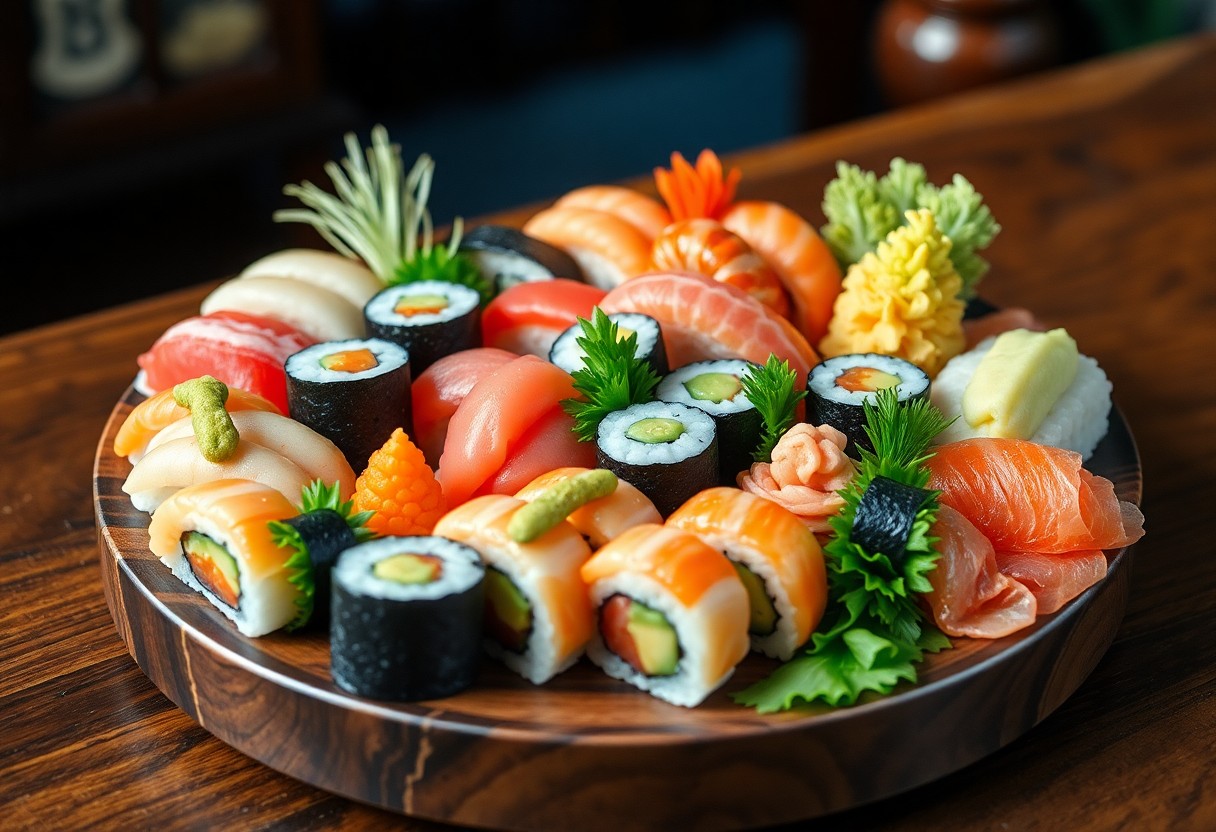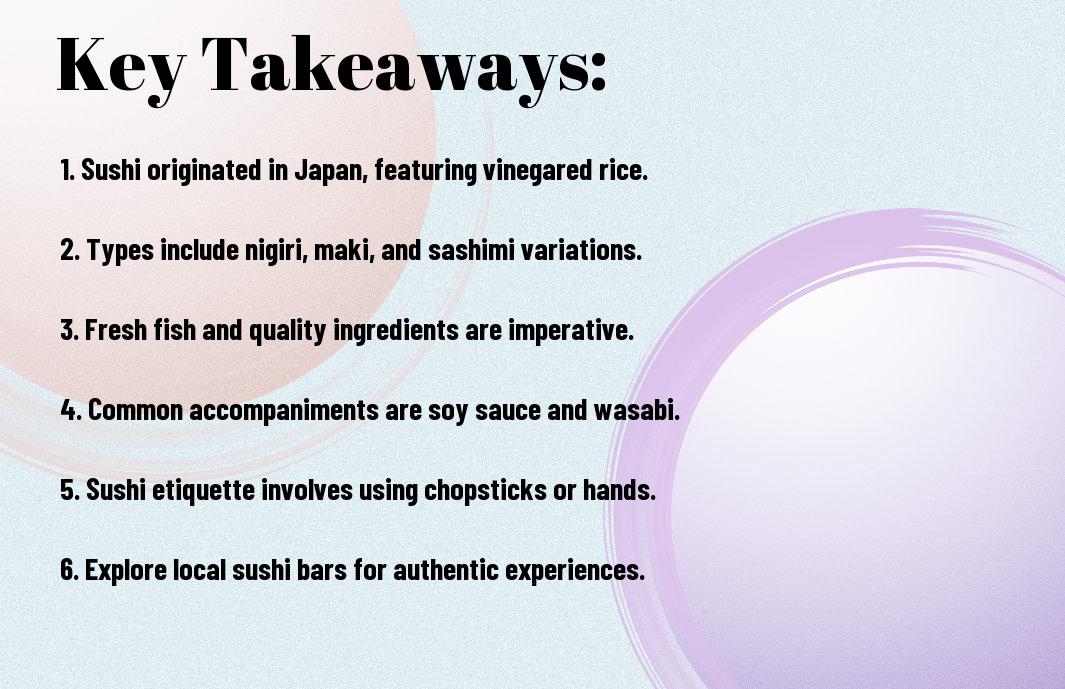Sushi is a beloved Japanese delicacy that combines rice with various ingredients, most commonly seafood. If you’re new to sushi, you might feel overwhelmed by the different types and styles available. However, this guide will introduce you to the world of sushi, helping you understand its components and how to enjoy it. You can further enhance your knowledge with our resource on From Nigiri To Maki: A Beginner’s Guide To Japanese Sushi. Dive into the rich culture and flavors of sushi!
Key Takeaways:
- Sushi Types: There are various types of sushi, including Nigiri, Maki, and Sashimi, each with unique ingredients and presentation styles.
- Ingredients: Sushi commonly features rice, raw or cooked fish, and seasonal vegetables, with emphasis on freshness and quality.
- Dining Etiquette: Understanding the proper way to eat sushi, like using chopsticks or hands and dipping sushi in soy sauce, enhances the experience.
- Sourcing Fish: High-quality sushi relies on fresh, sustainably sourced fish, making the choice of supplier important.
- DIY Sushi: Making sushi at home can be a fun and rewarding experience, allowing for creativity and customization with ingredients.
History of Sushi
For centuries, sushi has been a cherished part of Japanese culture, evolving from a method of preserving fish to the intricate culinary art form you see today. Its origins trace back to Southeast Asia, where fish was fermented with rice for preservation. As sushi traveled through different regions and eras, it incorporated local ingredients and techniques, shaping it into the diverse styles we enjoy now.
Origins of Sushi
At its inception, sushi was a means of preserving fish through fermentation with rice, a practice called narezushi. This method allowed the fish to be stored for extended periods, while the rice was often discarded. You might be surprised to learn this simple preservation technique was a precursor to the many sushi varieties you savor today.
Evolution Over Time
Any exploration of sushi’s evolution reveals a fascinating transformation influenced by geography and culinary practices. It transitioned from fermented fish to fresh varieties, with the introduction of vinegared rice in the Edo period, known as nigiri sushi. This revolution in taste paved the way for the sushi you enjoy in modern sushi bars worldwide.
It is fascinating to consider how sushi reflects the culinary journey of Japan. After the Edo period, sushi began to incorporate fresh fish and other local ingredients. The development of nigiri sushi in the 19th century made it quicker to prepare and serve, aligning with the fast-paced lifestyle of urban Japan. As sushi spread globally, diverse interpretations and fusion styles emerged, allowing you to experience an array of flavors and presentations that blend traditional techniques with modern creativity.

Types of Sushi
If you’re new to sushi, it helps to know the various types available. Each type offers a unique experience, making sushi a rich culinary adventure. Here are some common types you might encounter:
- Nigiri
- Maki
- Sashimi
- Temaki
- Chirashi
Assume that you will discover flavors and textures unique to each type as you try them.
Nigiri
For those unfamiliar, nigiri is a hand-formed mound of sushi rice topped with a slice of fish or seafood. It’s often accompanied by a small amount of wasabi and sometimes garnished with other ingredients like shiso leaves. The balance of rice and topping makes it a favorite among many sushi enthusiasts.
Maki
Above all, maki refers to sushi rolls that are wrapped in seaweed (nori) and filled with various ingredients like fish, vegetables, and rice. These rolls can vary in size and ingredients, making them versatile and enjoyable for all palates.
To broaden your sushi palette, you’ll find maki sushi in variations like uramakis, where the rice is on the outside, and hosomakis, which are smaller rolls typically filled with a single ingredient. These options allow you to explore different textures and flavors, enhancing your overall sushi experience.
Ingredients Used in Sushi
Despite sushi’s simple appearance, it boasts a variety of ingredients that create its unique flavors. Traditional sushi primarily consists of vinegared rice, fresh seafood, and seasonal vegetables, each contributing to the dish’s overall taste and presentation. Understanding these key ingredients will enhance your sushi experience and appreciation for this Japanese delicacy.
Rice
By using short-grain sushi rice, you ensure that your sushi has the perfect sticky texture for holding its shape. The process involves washing the rice to remove excess starch, then cooking it with precision to achieve the right level of moisture. Adding rice vinegar, sugar, and salt creates a slightly tangy flavor, which is crucial for harmonizing with the other ingredients in the roll.
Seafood and Vegetables
Around sushi, you’ll find a myriad of seafood and vegetables that add depth and character. Fresh fish like tuna, salmon, and eel are popular choices, while vegetables such as cucumber, avocado, and pickled radish offer a refreshing crunch and balance. This combination not only provides varied flavors but also reflects the seasons, ensuring that you enjoy the freshest produce available.
Further exploring seafood and vegetables, you’ll discover that sourcing high-quality ingredients is vital for an authentic sushi experience. Many sushi chefs seek local, sustainable fish, often serving it raw, lightly cooked, or marinated to enhance taste. Vegetables can range from simple garnishes to integral components of the dish, providing both texture and a pop of color. By experimenting with different combinations, you can create your unique sushi that suits your palate and celebrates freshness.
Sushi Preparation Techniques
Many sushi preparation techniques are important for creating this beloved Japanese delicacy, blending art and science. From selecting fresh ingredients to mastering the intricate processes, these skills elevate your sushi-making experience. If you’re looking for A beginner’s guide to sushi | Work in Japan for engineers, this overview will provide you with a comprehensive starting point.
Sushi Rolling
Against popular belief, sushi rolling is not merely about layering ingredients; it’s a careful balance of technique and finesse. Using a bamboo mat, you will learn to control the rice and fillings, ensuring every roll is tight and well-presented.
Food Safety Standards
At the heart of sushi preparation are the food safety standards that guide proper handling and storage of raw fish and other perishables. Following these regulations keeps your sushi safe to eat and enhances your overall culinary experience.
Consequently, you should always prioritize sourcing high-quality ingredients and maintaining cleanliness in your workspace. By adhering to food safety regulations, including proper refrigeration, cross-contamination prevention, and timely consumption, you can ensure that your sushi remains delicious and safe for you and your guests. Familiarizing yourself with local guidelines and best practices will help you navigate the world of sushi with confidence.
Sushi Etiquette
Keep in mind that sushi etiquette can enhance your dining experience and show respect for this traditional Japanese cuisine. Start by greeting your sushi chef and expressing gratitude for their craftsmanship. When seated at the sushi bar, avoid making excessive noise or engaging in loud conversations. Showing appreciation through a simple smile and polite manners will not only elevate your meal but also honor the cultural significance of sushi.
Eating Sushi Properly
With sushi, the way you eat it can be just as important as the quality of the ingredients. It’s perfectly acceptable to use your hands instead of chopsticks for sushi, particularly for nigiri. When dipping your sushi in soy sauce, aim to dip the fish side rather than the rice to prevent it from soaking up too much sauce. This approach preserves the dish’s intended flavors.
Common Practices
One common practice in sushi dining is to share your dishes with others. While dining, it’s polite to present your sushi to companions and encourage them to try a bite. This fosters a communal experience and highlights the joy of sharing. Additionally, when ordering more sushi, do so in a way that should not disrupt the flow of the meal.
Due to the cultural significance of sharing food in Japanese dining, engaging in this practice allows you to connect with your dining companions on a deeper level. It’s customary to avoid shaking hands or placing chopsticks upright in rice, as these actions can be associated with funeral rituals. Observing such practices not only enhances your experience but also reflects your understanding and respect for Japanese traditions.
Where to Enjoy Sushi
Once again, your sushi experience can be enhanced by the dining environment you choose. From high-end sushi bars offering a traditional omakase experience to casual eateries serving quick rolls, there’s a variety of places to savor this delight. Research local sushi spots or explore new restaurants while traveling to find the perfect place that suits your taste and budget. Your sushi adventure awaits!
Sushi Restaurants
Above all, sushi restaurants can range from quaint, family-owned establishments to upscale venues with chefs who have trained for years. Look for places that emphasize fresh ingredients and offer a diverse menu. Many sushi restaurants also provide the opportunity to watch skilled chefs craft your meal, making the experience even more enjoyable.
Preparing Sushi at Home
To truly enjoy sushi, you might consider trying your hand at preparing it at home. This allows you to customize ingredients and flavors to your liking while providing a fun, hands-on experience.
Hence, preparing sushi at home can be both a rewarding and creative endeavor. Start with basic rolls, experiment with ingredients, and watch tutorials for techniques like making sushi rice and rolling. Gather the necessary tools, such as a bamboo mat, and don’t hesitate to invite friends or family for a sushi night. This way, you can enjoy your sushi creations together, and it’s a great opportunity to bond over food.

Summing up
Conclusively, exploring sushi can be a delightful culinary journey for you. As you probe this exquisite Japanese delicacy, understanding its types, ingredients, and dining etiquette will enhance your experience. Whether you’re sampling your first nigiri or experimenting with rolls, this guide offers you a solid foundation. For a more comprehensive overview, check out the Sushi Guide for Beginners: What To Try & Dining Etiquette to elevate your sushi knowledge and appreciation.
Q: What is sushi and what are the different types?
A: Sushi is a traditional Japanese dish that consists primarily of vinegared rice combined with various ingredients such as seafood, vegetables, and sometimes tropical fruits. The most common types of sushi include:
- Nigiri: Hand-formed rice topped with a slice of fish or seafood. It may also have a dab of wasabi beneath the topping.
- Maki: Sushi rolls made by wrapping vinegared rice and fillings, such as raw fish or vegetables, in a sheet of nori (seaweed) and then slicing them into bite-sized pieces.
- Sashimi: While not technically sushi, sashimi consists of thinly sliced raw fish or seafood served without rice.
- Temaki: Hand rolls that are cone-shaped and filled with vinegared rice and various ingredients, often eaten with your hands.
Q: How is sushi traditionally served and eaten?
A: Sushi is typically served on a wooden or ceramic plate accompanied by condiments such as soy sauce, pickled ginger, and wasabi. When eating sushi, it is common to dip the fish side of nigiri into soy sauce, avoiding the rice to prevent it from falling apart. Sushi can be enjoyed with chopsticks, but it is also acceptable to eat nigiri with your hands. It’s often paired with green tea or sake to enhance the dining experience.
Q: Can anyone eat sushi, and what precautions should be taken?
A: Most people can enjoy sushi, but some precautions are advised. Pregnant women, young children, the elderly, and individuals with compromised immune systems should be cautious, especially when consuming raw fish. Opting for cooked sushi varieties, such as shrimp or eel, can be a safer choice. Additionally, always look for reputable sushi restaurants that adhere to food safety standards to ensure the quality and freshness of the ingredients used.
